HOME > Japan SPOTLIGHT > Article
Development of Decarbonization Technology Key to Achieving Energy Security & Environmental Protection in East Asia
By Guo Sizhi

Introduction
We are currently undergoing an energy crisis triggered by the Russian invasion of Ukraine and the conflict in the Middle East, in parallel with increasing damage caused by climate change. In these circumstances, the trend toward decarbonization in East Asia is drawing increasing attention. In this article, after a survey on the Industrial Revolution and the decarbonization revolution so far, I introduce some observations on the principal characteristics in the development of decarbonization technologies towards a carbon neutral economy in Japan, China, South Korea and Taiwan. I also mention my outlook on the creation of an alliance of decarbonized supply chain green industries to achieve carbon neutral economy in East Asia.
Industrial Revolution & Decarbonization Revolution
The decarbonization revolution is the transformation of recent industrial activity to realize a carbon neutral economy, involving technological innovation, new production patterns and attitudes in everyday life, and new industrial organization and management models for the reduction of carbon emissions. Decarbonization's technological domains are energy, transportation, manufacturing, and home and office related industries as shown in Charts 1 & 2. We are currently witnessing the arrival of this decarbonization revolution, which is the next generation industrial revolution towards a carbon neutral economy initiated by decarbonization technology.
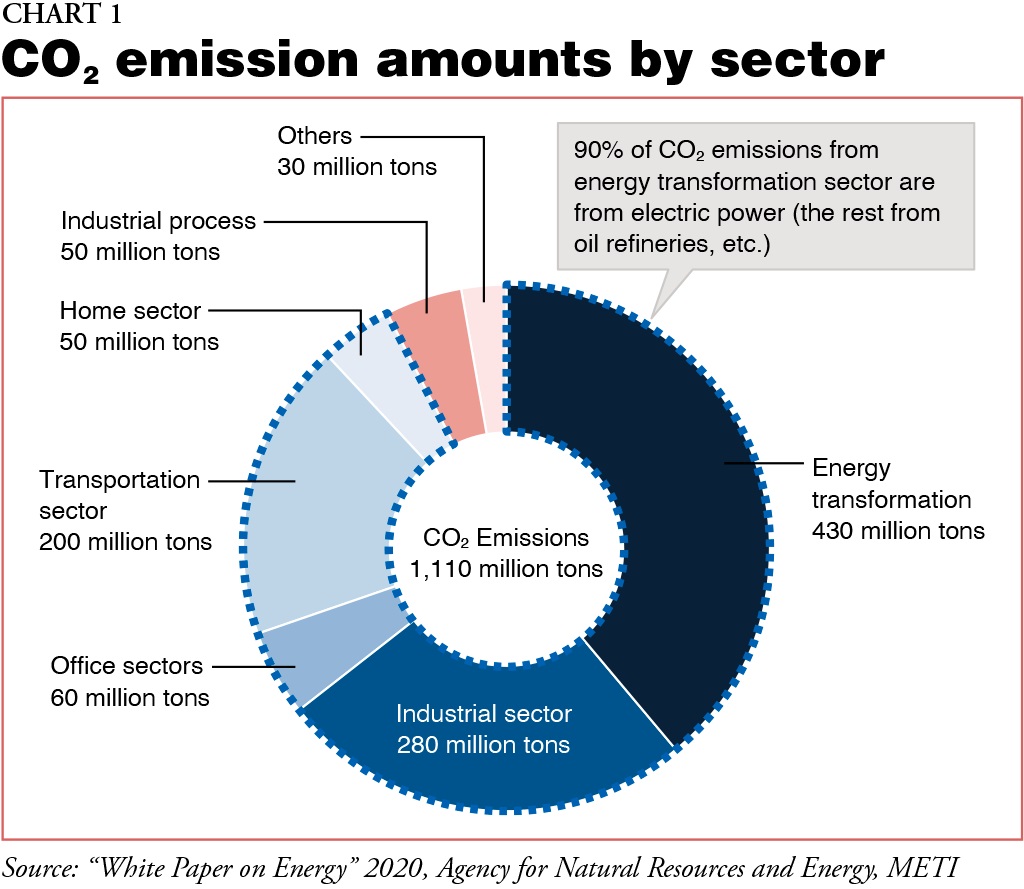
It is notable that previous industrial revolutions benefited from the influence of newly invented technologies that were passed on from generation to generation. There was a continuous succession of invented technologies superimposed at different periods. For example, in the second half of the 19th century, the second industrial revolution's "period of emergence" with heavy and chemical industries was superimposed on the "period of maturity" of the first industrial revolution (railroads and postal services). Likewise, the "period of emergence" of the third industrial revolution with the IT industry was superimposed on the "period of maturity" of the second industrial revolution with the services industry.
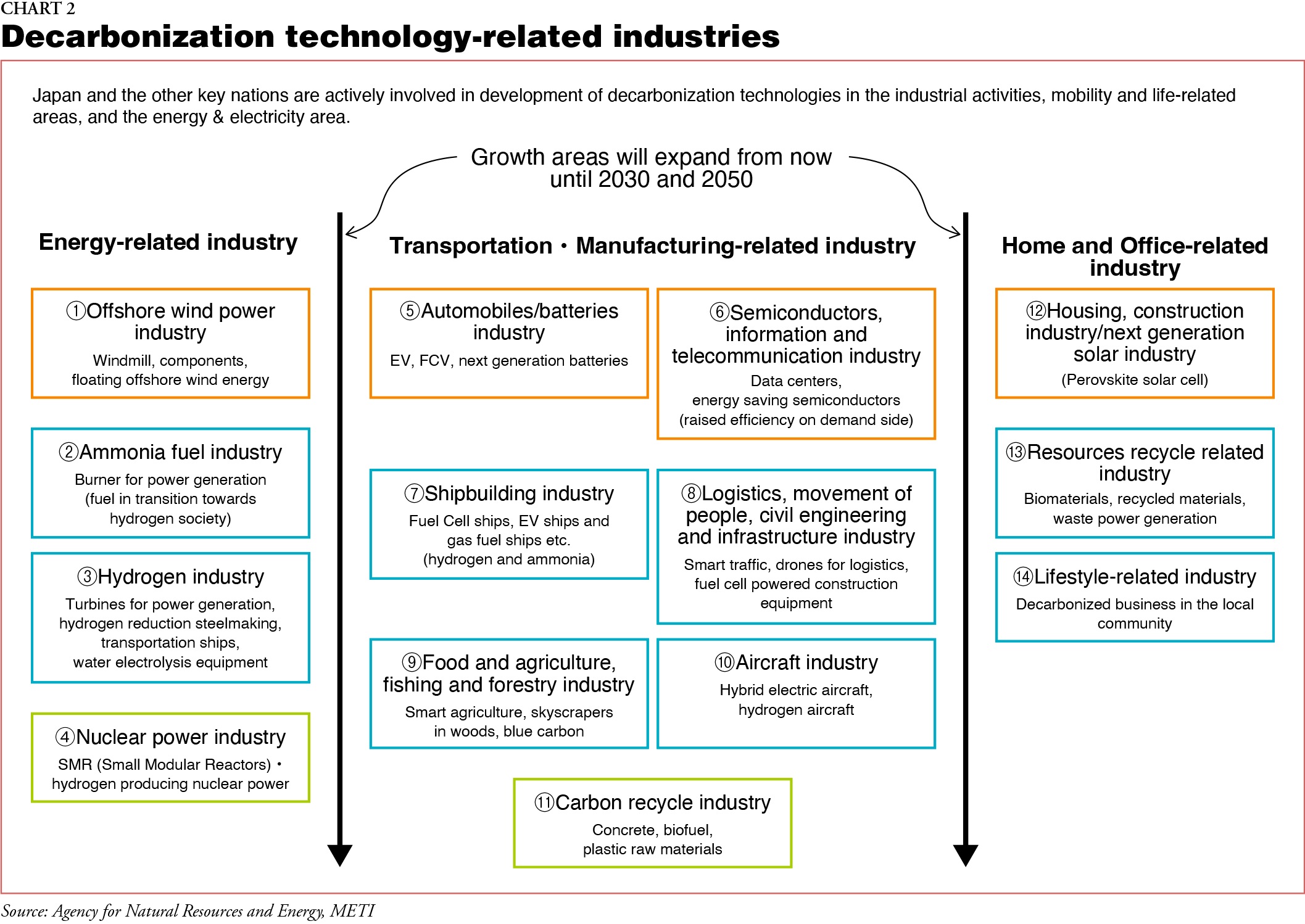
With those three industrial revolutions, the invention and development of technologies and products needed for human civilization and society were mostly exhausted, and so it is thought that it would not be easy to have further revolutionary innovations, and the opportunities to implement them would be restricted. However, since the beginning of the 2010s, the Fourth Industrial Revolution has been starting in areas like IoT, AI, and new energy. Innovations in this revolution are now starting to have a big influence upon economic society in the 21st century, and on human beings' production patterns, lifestyles and values.
The commonality among industrial revolutions so far has been the driving force of each revolutionary process. Coal and steam engines were the driving force of the first industrial revolution; in the second revolution it was petroleum, the internal combustion engine and electric motors; and in the third, nuclear power or renewable energy, and information and automation technologies were highlighted. The driving force of the fourth industrial revolution is technology for utilizing Big Data such as AI and IoT and technologies enabling fossil fuel and non-fossil fuel energy to co-exist with the network capacity and fossil fuels as the main players.
Each industrial revolution's core technology was considered critical. But it was necessary to manufacture products by machines that embodied that technology. In each industrial revolution, product manufacturing was achieved by a mechanical system using the core technology. For example, the steam engine--the core technology and detonator of the first industrial revolution--produced textile goods by operating spinning machines through a system of transmission to make them work as precisely as possible.
Likewise, the internal combustion engine and electric motors in the second revolution helped create products and vehicles by activating transportation machines and machine tools. Automation control and computing technology, as keys of the third revolution, provided operating machines with computing capacities and memory equipment and thus enabled them to produce more efficiently.
In the fourth industrial revolution, the key innovative technology of IoT combines IT with machines and goods, and thus realizes Internet-connected production and distribution in the economy. Its main areas of application are manufacturing, health care, logistics, agriculture and traffic. As this revolution proceeds, decarbonization is accelerated towards a carbon neutral economy. Table 1 lists many of the new technologies and R&D towards decarbonization that the world can look forward to.

The driving force of the decarbonization revolution is the development and utilization of new and renewable energy sources and decarbonization technology in sectors like industries and mobility. Above all, technology to store green energy, such as a next generation battery, will be a vital part of future industrial policy.
My own view is that the driving force technology of industrial revolutions has become increasingly complex, diversified and comprehensive.
It took more than 100 years since the first revolution to have a second one. Around another 100 years was needed from the second one until the third one. But it took only about 50 years from the third one to the fourth. This is because technological innovation has been accelerated significantly. The fourth industrial revolution and the decarbonization revolution that has just begun are even more closely interconnected and the interval between them will be shortened further.
Though the next-generation industrial revolution is still in the early stages, we are starting to see its key technology, driving force and principal energy sources. I believes they will be hybrid. Its key technology and driving force are the utilization of IoT and AI and additionally next-generation new and non-fossil energy technology--more specifically, electric power and energy conservation technology such as all solid state batteries co-existing with IoT and AI, and also hydrogen engines. Their energy sources will be non-fossil energy like renewables.
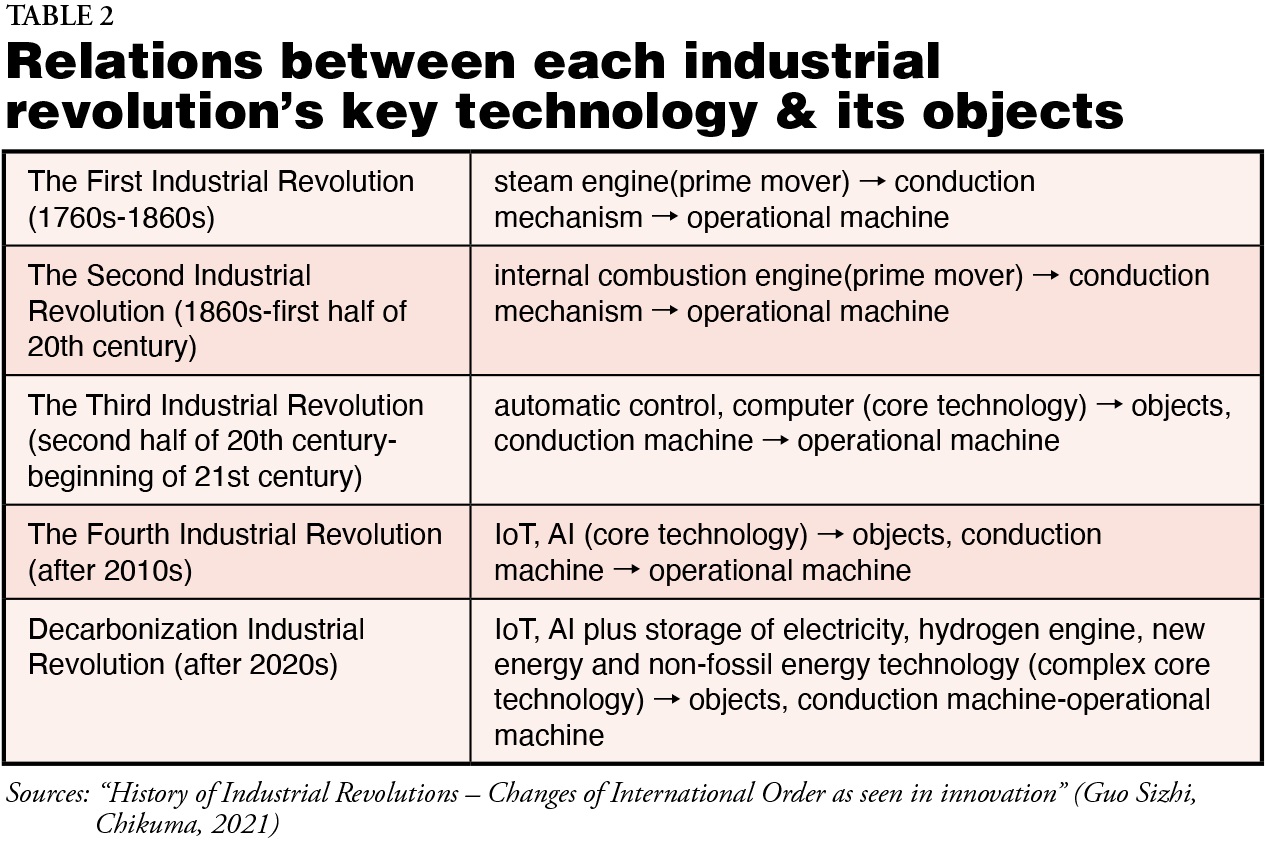
The common factor among industrial revolutions so far was that through their core technologies--the driving force behind each one--the revolutions were realized by combining manufacturing machinery equipment with non-manufacturing services. The impact of such industrial revolutions depends upon how closely they are combined and the quality of the combined elements (Table 2). In other words, if the quality of those objects like machines and facility equipment is low, the impact of the driving force and key technology would be limited.
It is expected that the decarbonization revolution will play a leading role in the next-generation industrial revolution as a driving force and detonator, a common technological characteristic among the industrial revolutions so far.
Developed Decarbonized Technology in East Asia & Their Characteristics
1. Main Examples of Developed Decarbonized Technologies in Japan, China, South Korea & Taiwan
In recent years, with decarbonization in progress, East Asia has been actively working on technological development and the social implementation of decarbonization in aquariums, power semiconductors, all solid state batteries, and Carbon dioxide Capture, Utilization and Storage (CCUS). Above all, the development and introduction of hydrogen has been drawing attention all over the world. Here are some specific examples of hydrogen development and application.
In Japan, an "Association for the Promotion of a Hydrogen Value Chain" was established in December 2020, aiming at building an alliance among organizations working on hydrogen. Some 250 companies had joined by August 2021. Mitsubishi Heavy Industries Ltd., in its pursuit of early commercialization of a hydrogen gas turbine with hydrogen as fuel, founded the "Takasago Hydrogen Park" where it can test all technologies ranging from hydrogen production to power generation. It plans to commercialize products produced in a large gas turbine through mixed combustion with 30% of the used fuel being hydrogen, and in small and medium-sized gas turbines which use 100% hydrogen fuel. The park was built next to a combined cycle power station for demonstration and Mitsubishi has started trials and demonstrations of technologies for hydrogen production and storage, and also burning hydrogen in a gas turbine.
Meanwhile, a new big electric power company, eREX Co., Ltd. has collaborated with Hydrogen Technology (HT) and started continuous operation of a hydrogen power station with around 320 kilowatts constructed in the city of Fujiyoshida in Yamanashi Prefecture in April 2022. They have started power generation of 270 Nm3 (normal cubic meter) of hydrogen per hour provided by HT. Incidentally, in a New Energy and Industrial Technology Development Organization (NEDO) project, Obayashi Corp. and Kawasaki Heavy Industries, Ltd. succeeded, for the first time in the world, in providing heat and power by gas turbine generation with 100% hydrogen fuel in the city in their demonstration on April 19 and 20 in 2018.
In China, Ningxia Baofeng Energy Group Co., Ltd. in Ningxia has started water electrolysis hydrogen production using solar power. In the first stage of the project, in April 2020, they started construction of a 100 megawatt power generation plant and electrolyzed water device with a 10,000 Nm3/hour hydrogen supply capacity, and those facilities started to work in April 2021. At the end of February 2022, this company started to operate 30 facilities for water electrolysis for the production of green hydrogen. It imported those facilities. Currently, its produced hydrogen, around 33 million tons per year, is the largest in volume in the world, but mostly originally coming from fossil fuel and industrial by-products, which is called grey hydrogen.
In South Korea, a "Korea H2 Business Summit" was held in September 2020. Twelve large enterprises like Hyundai, SK, Hanwha, GS, PSCO, and Lotte Chemical participated. All the participating companies plan to invest 43 trillion, 40 billion won by 2030 and start to build up and secure a hydrogen supply chain covering hydrogen production, storage, and Fuel Cell Vehicles. In May 2022, Lotte Chemical HQ, the largest ammonia distributor in South Korea, and Sumitomo Corporation initiated a test project for hydrogen production through ammonia decomposition for the first time in the world by using Syzygy's photocatalytic reactor.
In Taiwan, in February 2020, a "New Generation Energy Research Team" consisting of Taiwan University, the University of Science and Technology in Taiwan and Tokai University, with planned support from the Science and Technology Department of the Taiwanese government, succeeded in developing new photo-electrochemistry hydrogen production technology combining ultra-thin atomic layer material, graphene and silicon material and thus contributed to the creation of clean hydrogen energy from solar energy, and that resulted in raising the efficiency of conversion by 20%. The high cost of hydrogen production still remains a serious challenge.
National Sun Yat-sen University in Taiwan and Kaaz Corporation in Okayama Prefecture in Japan which specializes in agricultural machinery concluded a joint research agreement on hydrogen energy in 2022. They are working on development of an engine using hydrogen as fuel based on a small gasoline engine developed by Kaaz, aiming at its completion in 2027.
2. Characteristics of Decarbonization in Japan, South Korea, Taiwan & China
Each of the four nations has its own characteristics regarding social institution and stage of economic and industrial development. In Japan, decarbonization technology such as hydrogen, electricity storage technology, power semiconductors and CCUS is the best in the world in terms of stock base. So its decarbonization technology knowhow and its accumulation gives it some advantages.
South Korea's hydrogen, solid state battery and power semiconductor development is more advanced than in China and Taiwan and it is now getting seriously engaged in such development with closer collaboration between the government and the business sector.
In Taiwan, its uniqueness is in R&D in the national research institutes and universities and also its collaborative engagement with Japan. However, it needs to promote further applications and reduce production costs, as well as strengthen its international competitiveness.
In energy decarbonization, Japan excels in technologies for coal-fired power generation or hydrogen power generation, but it still faces high costs of renewable energy development and solar power generation (the cost of solar panels and their facilitation is higher than in Europe).
In China, the government and private sector together promote decarbonization technology development mainly among national enterprises. In areas like renewable energy development and transformation of electric power or EV, they have achieved remarkable progress with the largest market share in the world (wind power generation capacity: 329 gigawatts and 39.9% of the world total; solar power generation capacity: 306.4 gW, 36.3% of the world total). However, their decarbonization in industries or technological development and application have not yet reached the level of Japan, South Korea and Taiwan. Energy and resource-intensive industries like steel and chemicals are the leading industries in their manufacturing, but their carbon productivity is lower than in Japan, South Korea and Taiwan (Table 3). They suffer from a lack of accumulated knowledge of decarbonization technologies.
3. Feasibility & Need for Regional Alliance

As shown in Table 3, in East Asia each nation's primary energy sources' relation to GDP, CO2 emissions per GDP, and carbon productivity differ from each other. Above all, it is notable that China's performance is much worse than any others. I think that from now on these four nations should try to reduce their greenhouse gases (GHG) through the division of labor, or through mutual complementarity to achieve decarbonized industrialization, while taking advantage of each nation's strength in technology, knowhow, human resources, markets, and financial capacity.
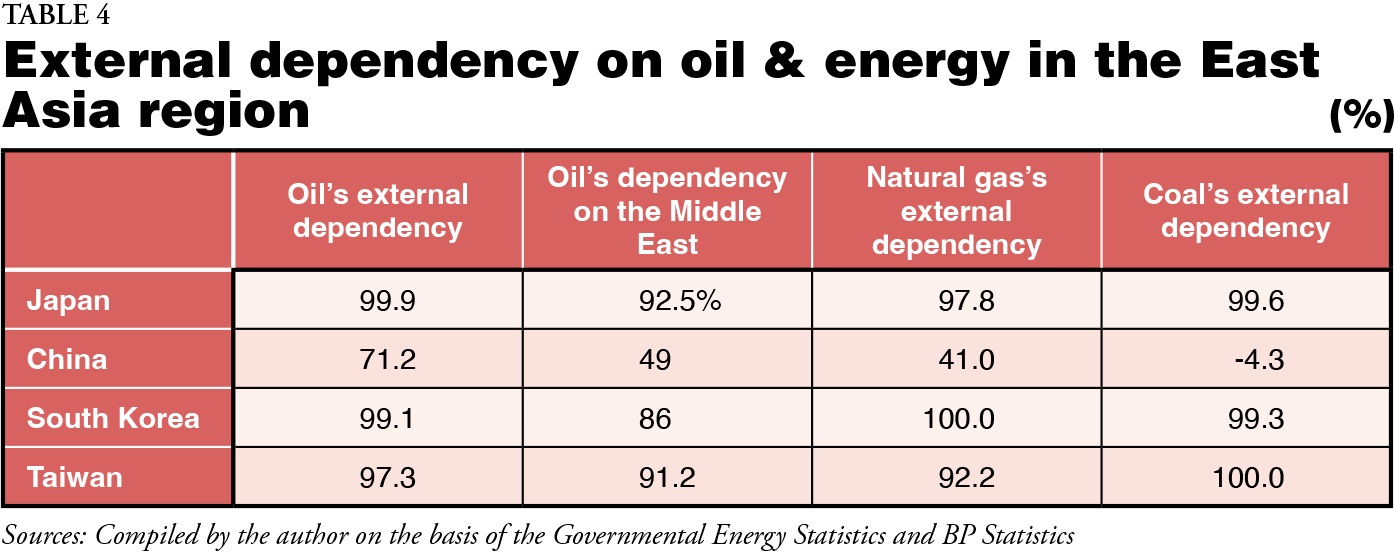
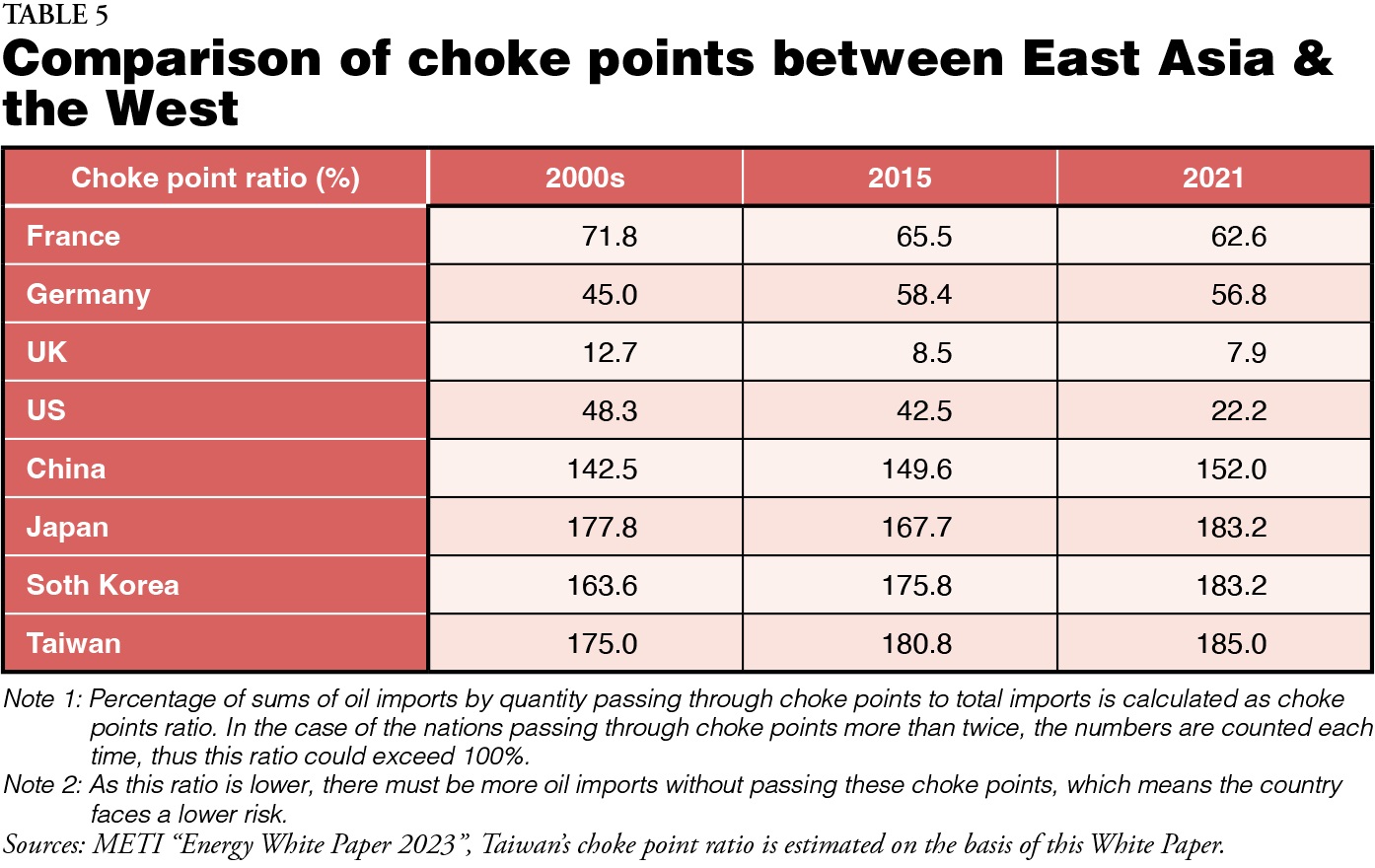
On the other hand, it should also be noted that East Asia is vulnerable in energy supply. As shown in Table 4, external dependency for oil and energy in Japan, South Korea and Taiwan is very high, more than 90%, and even in China, external dependency on oil and natural gas has been rising recently, having respectively reached 71% and nearly 50%. Thus, in comparison to Europe and the United States, energy dependency of these four nations on the Middle East comes with a high geopolitical risk (Table 5 & Chart 3).
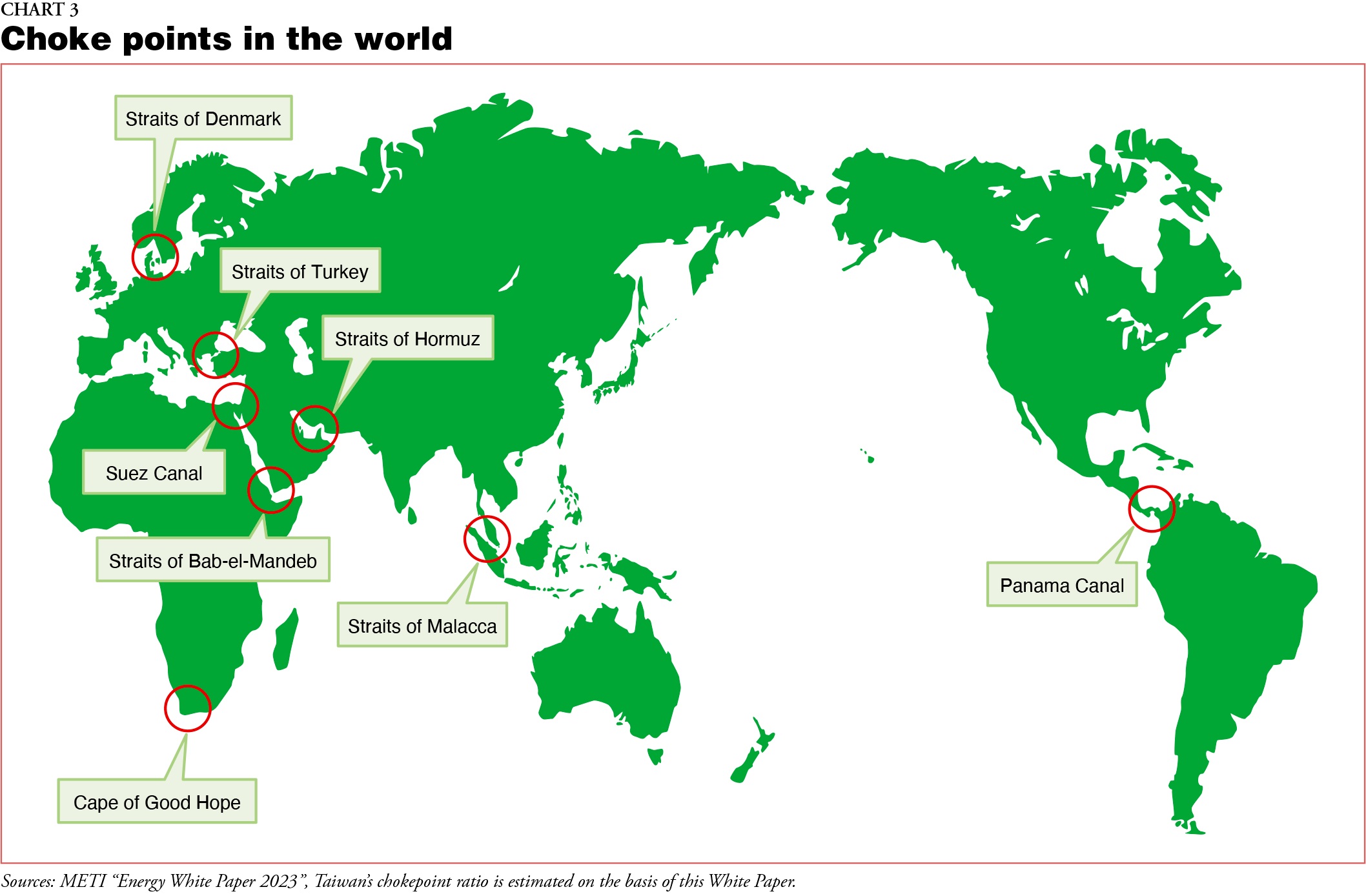
In addition, it should be noted that the East Asia region is much oriented towards coal-fired power generation (Chart 4). The percentage of coal-fired power generation among the four nations is much higher than the 20.4% among the OECD nations. Above all, the percentage in China alone is 63.3%. Thus, it is urgent for these four to expand decarbonization, renewables and new energy sources, and reduce their external dependency on fossil fuels like oil and coal.
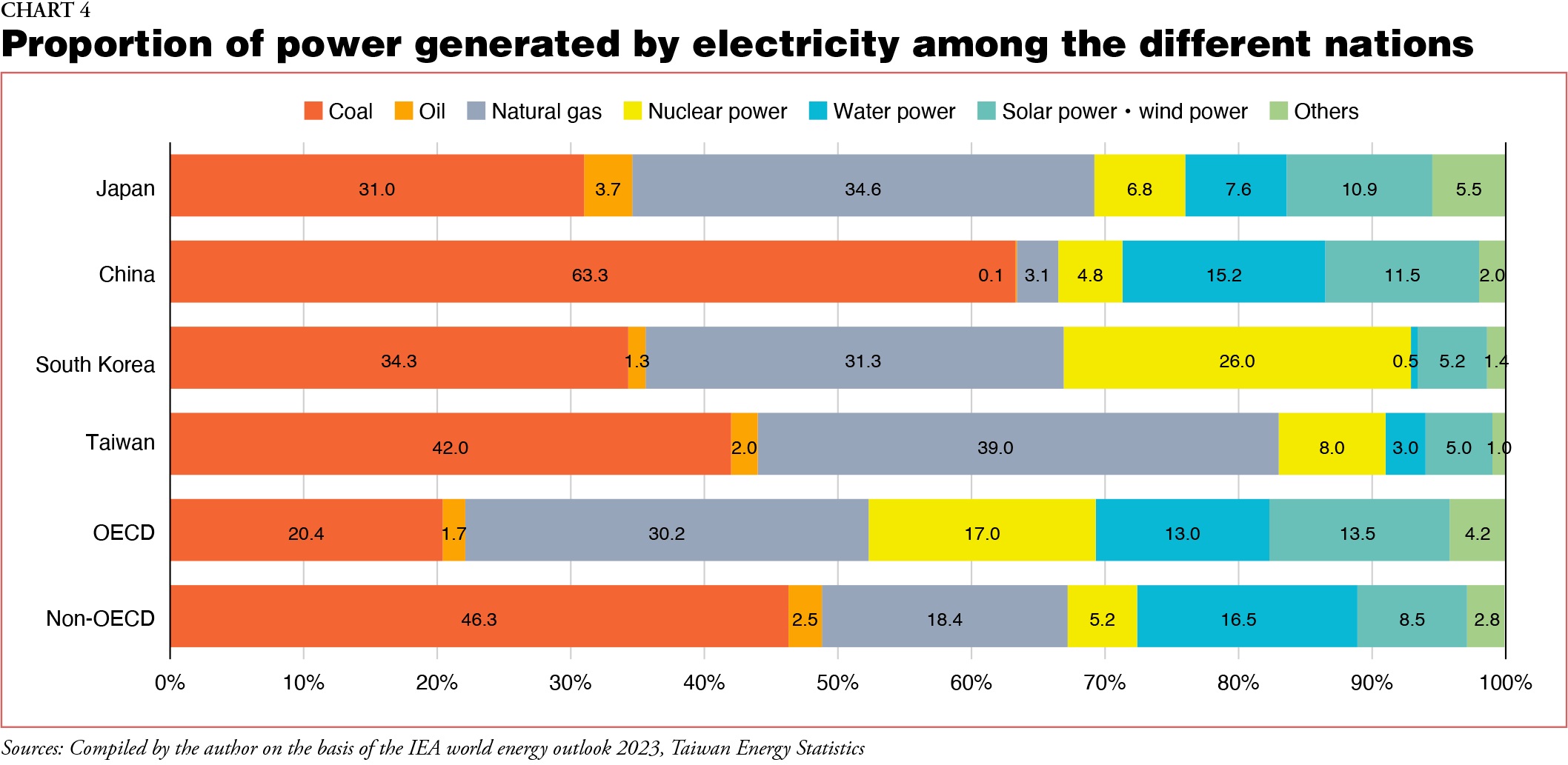
Through cooperation or alliances, they could reduce their GHG emissions and achieve energy security, environmental protection and economic growth in the period of transition to decarbonization. It is hugely important that they restrict coal consumption, which is mainly responsible for the GHG emissions in the region, and jointly expand the use of renewable power generation as a whole region.
Conclusion: Challenges & Prospects for the Future
At this moment, Japan, China, South Korea and Taiwan need to cope with the expanding climate change crisis and geopolitical risks by reducing their CO2 emissions and their dependency on fossil fuel energy through decarbonization.
1. Challenges in East Asia
It will be important to resolve the challenges in the area of decarbonization facing the four nations. Those challenges are as follows:
First, they need to promote further application of patents for decarbonization technology in the region and thus lower the cost of technological development.
Second, they must secure human resources related to decarbonization and promote the application of decarbonization technology overseas and strengthen its international competitive advantage.
Third, they need to enhance the added value of industries and upgrade technologies, as well as strengthen decarbonization technology development and implementation in traditional energy-intensive industries, as in China with intra-regional collaboration.
Finally, by improving the quality of technology development rather than the quantity by creating a good R&D environment among private companies, they should develop new technologies to address the shortcomings of decarbonization technology. They should learn from each other???s advantages and strengths and jointly cope with risks and issues.
2. Prospects
In the East Asia region, exports and imports among these four nations, and their mutual dependency through trade, are high (Table 6). Against this background, intra-industry divisions of labor or intra-firm divisions of labor achieved by multinationals are promoted in the domains of renewable and new energy, EVs, batteries, hydrogen electrolyzers, power semiconductors, and decarbonization technologies like CCUS.

Expanded trade among decarbonized industries and the build-up of supply chains could be achieved by taking advantage of each of the four nations' comparative strengths. They should consolidate industrial divisions of labor or complementarity in decarbonized industries and their supply chains by utilizing East Asia's existing trade and industrial division pattern.
Under private sector initiatives, they should strengthen alliances among East Asia's decarbonization and green industries, and in the near future should try to create an East Asia Decarbonization Community, including ASEAN countries.
Article translated from the original Japanese by Naoyuki Haraoka.
Japan SPOTLIGHT July/August 2024 Issue (Published on July 24, 2024)
(2024/08/13)
Guo Sizhi
Dr. Guo Sizhi is Specially Appointed Professor at Teikyo University Okinaga Research Institute; Consulting Fellow at the Japan Economic Foundation(JFE).He specializes in the international economy, the energy economy, and the Chinese economy. His current research focuses on the transformation of the international political and economic order, new energy, and economic security toward carbon neutrality, and decarbonization technology innovation. He is the author of numerous books, including A History of the Industrial Revolution: The Transition of the International Order as Seen Through Innovation and The Decarbonizing Industrial Revolution.

Japan SPOTLIGHT

- Coffee Cultures of Japan & India
- 2025/01/27























